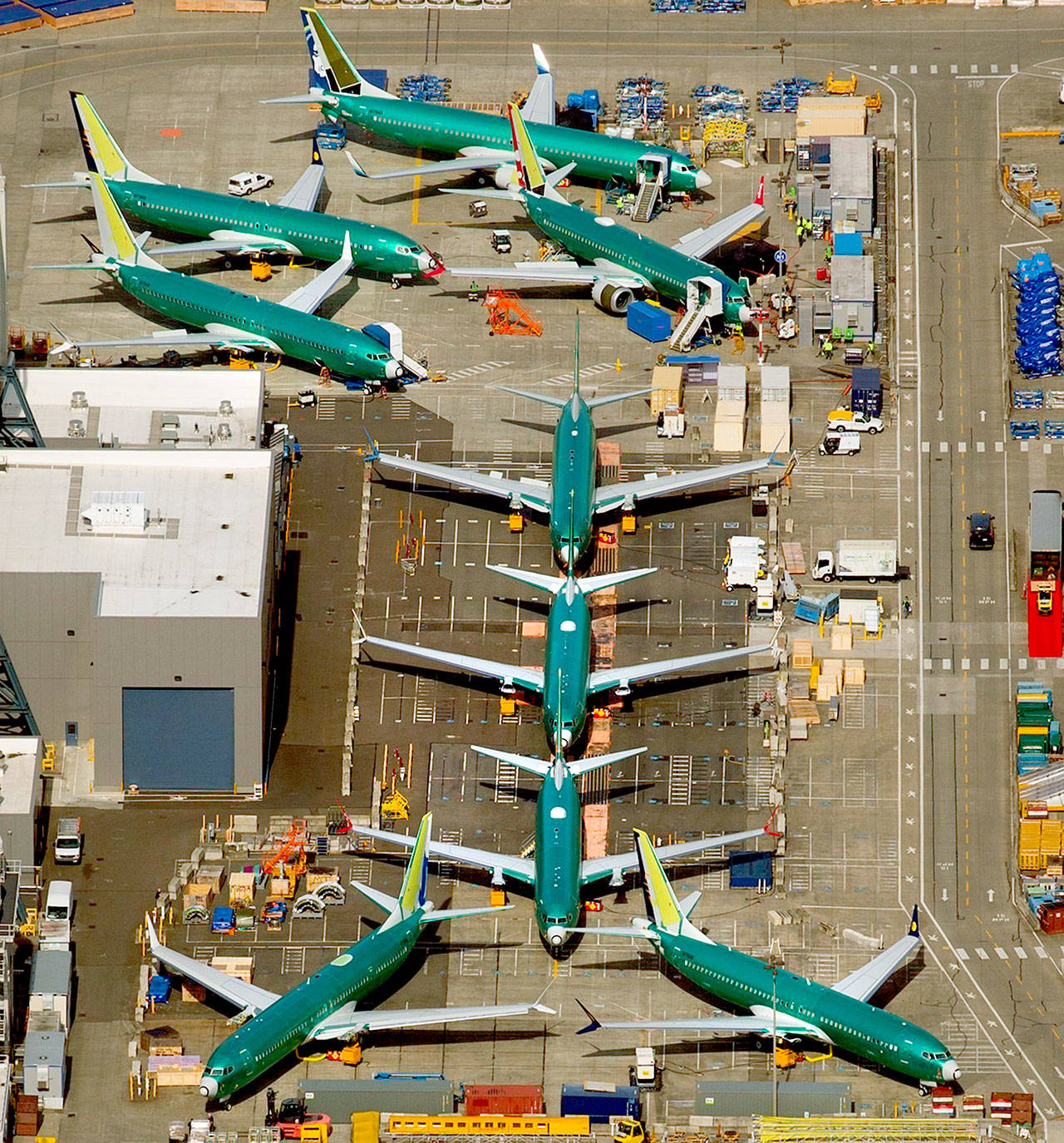Herald news services and staff
CHICAGO — The Boeing Co.’s dismal third-quarter financial results underscore how swiftly the worldwide grounding of the 737 Max has choked the company’s No. 1 line of business — and how urgently Boeing needs the jet back in the air.
With undelivered 737s parked at several airports around the country, including Everett’s, revenue fell to $20 billion, down 21% from a year earlier. Profit fell 51% to $1.17 billion, Boeing said Wednesday.
Meanwhile, CEO Dennis Muilenburg warned that trade tension with China — the company’s biggest foreign market — threatened sales of wide-body planes like the 787, which is built in Everett and North Charleston, South Carolina. The company plans to cut the 787 production rate from 14 planes a month to 12 for about two years, starting later this year.
“I think the recent trade discussions have been productive — they’re moving in a good direction,” Muilenburg said on a call with financial analysts. “But for purposes of our company, we have to be very disciplined in our production rate management” — hence the 787 rate cut.
The Chicago-based company declined to say whether or how that might affect the size of the workforce. “This will impact production at both sites, albeit minimally,” said spokesman Paul Bergman. “While we don’t breakdown production rates by site, we will adjust the overall program production rate in a way that best meets the needs of the program, our customers and our workforce.”
Another Everett wide-body airplane program remains stalled, executives said during the conference call Wednesday. Boeing now aims to begin delivering the newest version of the big 777 airliner in early 2021. Problems with engines made by General Electric have delayed the first test flights for the 777X.
But the Max crisis is job one, Muilenburg said. Ahead of the teleconference with analysts, he said in a statement that “our top priority remains the safe return to service of the 737 Max, and we’re making steady progress.” The CEO is scheduled to testify in Congress next week.
Amid the delivery freeze and sharply slowing sales, Boeing needs regulators to approve proposed software fixes for the Renton-built 737 Max in coming months. Airlines have said they plan to return the jet to service as soon as January, but that timeline depends on Boeing satisfying global aviation authorities as well as the U.S. Federal Aviation Administration.
On the call with analysts, Muilenburg cautioned that a further delay in regulator approvals for the 737 Max could force the company to consider cutting production again — or even a “temporary shutdown of the Max production line.”
For now, though, the company plans to increase production of the jet to 57 per month by late 2020, up from a pace of 42 a month currently. Boeing lowered production from 52 a month after the Max was grounded March after two crashes killed 346 people.
The troubled plane is a drag on the company each day it remains grounded. Boeing reported that it has added another $900 million in costs for the Max, and deliveries of new planes tumbled from a year ago.
In the third quarter, Boeing delivered just five 737s compared to 138 of those planes during the same period last year. The company did not break down those figures by 737 model, but those five deliveries are likely older 737 NG variants unaffected by the grounding. Through September, just 118 737s had been delivered in 2019, compared to 408 through the third quarter last year.
Without revenue from deliveries of the 737, Boeing is hemorrhaging cash. Free cash flow went from $4.1 billion a year ago to a negative $2.9 billion, and the company has taken on $5.5 billion in new debt.
Boeing’s stock has fallen 24% since early March. Analysts at Credit Suisse downgraded the stock this week, saying disclosures about Boeing’s handling of safety issues “may shatter the fragile trust between regulators and Boeing.”
Boeing has completed work on software changes to a 737 Max flight-control system called the Maneuvering Characteristics Augmentation System, which activated mistakenly and pushed down the noses of both planes that crashed — in Indonesia last October and in Ethiopia in March.
On a call with analysts and reporters, Muilenburg said Boeing began submitting key elements of its fix to the FAA in September.
“We are diving deep into the documents, we are answering all the questions, and the FAA is taking the time to make sure we get it right,” he said.
The next major step is scheduling a certification flight with the FAA. Executives gave no estimate for when that might occur.
The crisis is already reshaping Boeing’s leadership. Muilenburg, still CEO, was stripped of the title of chairman of the board — an effort by the board to provide a stronger check on his power. And Boeing said this week that Kevin McAllister, the executive who oversaw the 737 Max as head of the Boeing Commercial Airplanes division, resigned from that role and was replaced by company veteran Stan Deal.
Despite the financial impact of the Max crisis, Boeing has maintained payments to shareholders at a high level. During the quarter, the company paid out $1.2 billion in dividends, reflecting a 20% increase in dividends per share compared to the same period of the prior year.
The company’s stock on Tuesday closed at $340.50, up 1%.
The Associated Press, The Washington Post and The Seattle Times contributed.
Talk to us
> Give us your news tips.
> Send us a letter to the editor.
> More Herald contact information.

























